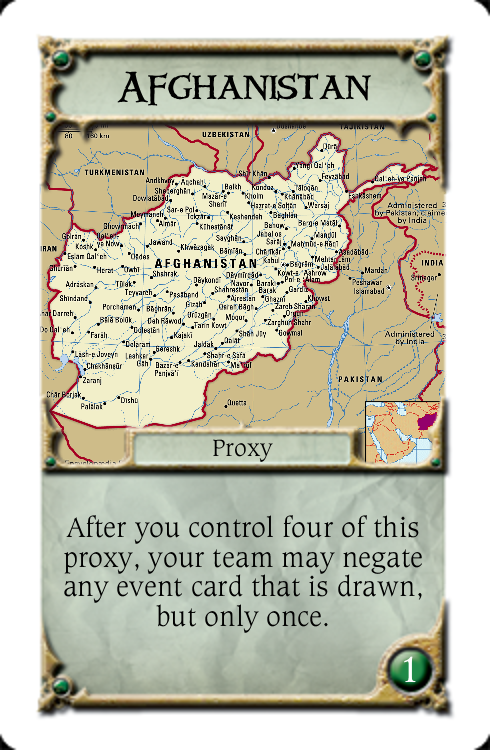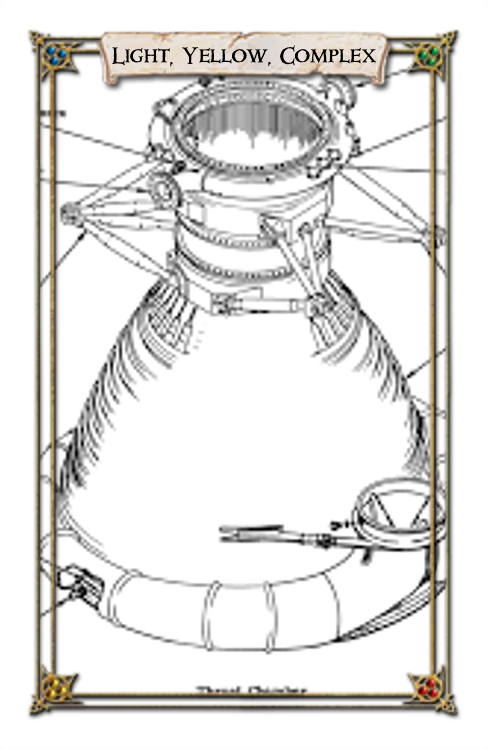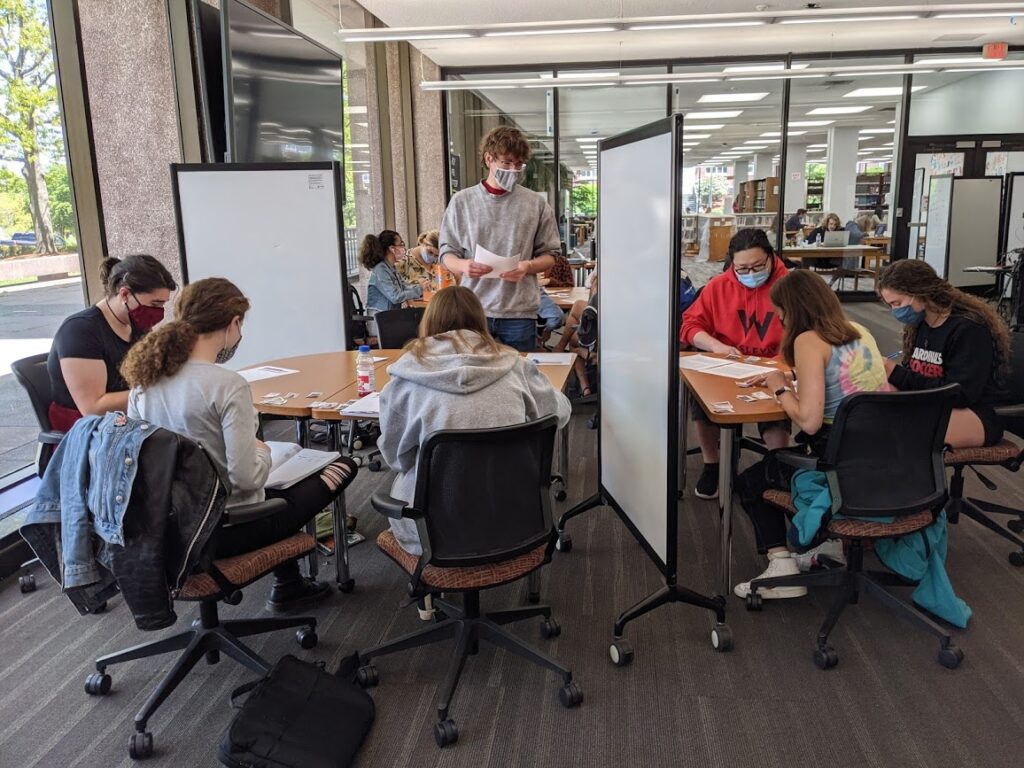Moon or Bust!
A game by Simon van Baaren

For a background of the game, please consider reading the Critical Introduction attached below
Moon-or-Bust-Critical-IntroductionDownload
Rules
Moon or Bust! is a semi-cooperative game for 6+ participants ages 13 and up.
Components:
- Four notebooks, two for Engineers and two for Politicians
- Four pencils
- A 90 second timer
- Two decks of 39 Component cards
- Two sets of 20 Proxy cards
- Two sets of 6 Sabotage cards
- A 30 card Event deck
- Two six-sided dice
- One twenty-sided die
- A large divider
How to Win:
A team wins the game if, at the end of any turn, their Engineers have submitted a combination of three components that match those noted on one of their solution cards, and a mutual loss has not occured. If both teams simultaneously submit winning combinations, the game is considered a draw. Even if a team seems to have won, play must proceed through to the end of the turn in case a mutual loss occurs and the win is negated.
How to Lose:
Both teams lose the game if, at any time, a member of either team rolls the twenty-sided die and the result is lower than the threat level recorded on the notepad of that team’s Politician(s). A team also loses if their opponent wins.
Setup:
- Divide players into two teams of equal size. If there is an odd number of participants, one team may have an extra member.
- Allot a Component Deck, Proxy Cards, and Sabotage Cards to each team.
- Stand up the divider on the table between the two teams. Ensure that neither team can see the cards on the other side of the divider.
- Choose to play in historic mode or standard mode. If the game is being played in historic mode, arrange the event deck in numerical order, with card number 1 placed on the top. If playing in standard mode, shuffle the event deck instead. Then place the event deck to the side of the divider, so that it is visible to both teams.
- Allocate members of the teams to each role. The roles are Agent, Politician, and Engineer. The number of participants occupying a given role should be the same for both teams. If there is an extra participant on one team, it is recommended that they pay as an additional politician for their team.
- Ensure that each team member is familiar with the rules section for their role.
- Shuffle the Solutions Deck. The politician(s) from each team may draw a single card from the deck, look at it privately, and place it face down next to the event deck. Then, they may collectively look at a third card and place that alongside the other two. These cards denote the winning combinations for the game. The politicians may write down these solutions on their private notepads. Place the rest of the Solutions Deck back in the box.
- The politician(s) of each team privately roll two six-sided dice. They must subtract the rolled number from zero, then write down the total on their private notepad. (If a four and a three are rolled, the number they write is -7.) This is their team’s starting threat level. They may also note their team’s initial PR: 3, and initial funding: 300. Unlike the privately kept threat level and rocket solutions, these values will be publicly communicated.
- If all players are ready to start, the game may begin.
Playing a Turn:
- Draw an Event Card
One of the politicians must begin the turn by drawing a card from the event deck and reading it aloud for everyone else at the table. All players must abide by its rules as play continues.
- Begin Play
If you are playing in Fast Mode, flip the 90 second timer. Play for the round ends when the timer runs out. If you are not playing in Fast Mode, forgo the use of the timer. All members of both teams may simultaneously begin to complete the tasks noted in the Play sections of their individual roles. Free play ends whenever all players have finished conducting strategy, talking with teammates, and carrying out necessary tasks. When everyone is ready, proceed to the next phase.
- Reveal Proxy Cards and Sabotages
The Agents of both teams reveal their proxy cards simultaneously. Each proxy card they choose to reveal decreases the PR of their team by 1. If both teams reveal two identical proxy cards, they negate one another, but the PR is still lost. Afterwards, place these cards next to the event deck, where they can be seen publicly. Each team will gain the bonuses listed on their event cards during subsequent turns of play. After this, both teams reveal their Sabotage Cards simultaneously. Agents announce which test each sabotage will be applied to.
- Test Rockets
The Politicians of each team consult the combination(s) put forward by their Engineers, otherwise known as tests. They also consult the sabotage cards given to them by the opposing Agents. If this is the tenth turn or greater, both teams gain the option to nullify Sabotage Cards by paying $200 for each Sabotage played against them. They then announce how many of the components were correctly chosen in each test, accounting for the negative effects of the sabotage cards. If all three components were correct on a single test, that team will win the game at the end of the turn.
- Roll for Conflict
Increase the threat level of both teams by 1, then roll the twenty sided die. If the result is lower than either team’s individual threat level, they must reveal that threat level to all other players at the table. War has begun! This immediately ends the game in a mutual loss for both teams, even if one of them just submitted a winning rocket test.
- Begin Again
If the game has not ended, another turn starts once all players have prepared themselves. Each team gains 1 additional PR and 100 additional funding, plus any additional bonuses from events and proxies.

Individual Play:
Engineers
During a round of play, Engineers may do the following:
- Ask their Politician(s) for funding. For every 100 funding the engineers receive, Engineers may perform one rocket test, unless the effects of an Event Cards or Proxy Card says otherwise.
- Construct a rocket test. Engineers may look through all the cards in their Component Deck and choose a Nose Cone, Fuselage, and Thruster from among them. One of each type of component must be used, unless another rule says otherwise. They group these components together and present them to the Politician later in the turn. Engineers are encouraged to take notes and keep a record of the combinations they test. If additional tests are being conducted, Engineers must assemble another combination of three parts for each additional test. They may not test the same component more than once per turn.
- Converse with other players. Engineers may speak with anyone else on their team, but the Politician is forbidden from revealing any aspect of a winning combination to the Engineers, or revealing their threat level.
Agents
During a round of play, Agents may do the following:
- Ask their Politician(s) for PR. For each 1 PR that Agents receive, they may play a Proxy Card at the end of the round. They may also conduct sabotages for 1 PR each.
- Look at the opponents’ cards. Agents may move around to the other side of the barrier and look at what the other team is doing, but they may not pass on this information to anyone else on their team.
- Sabotage. Agents may submit a sabotage card to the opposing Politician, if they receive the funding to do so. The card they submit should indicate which of the three components of a rocket are being sabotaged. Agents specify which test they’d like to sabotage..
- Converse with other players. Agents may converse with anyone. However, the opposing team is under no obligation to reveal any information to them, and may lie about their strategy if they wish.
- Choose Proxy Cards. If they are allocated PR, Agents may pick the Proxy Cards to play at the end of the round.
Politicians
During a round of play, Politicians may do the following:
- Allocate funding and PR. The other players will ask the Politicians for funding and PR, and they must decide how much to give in each round, keeping track of the values in their notebook as they change. At the end of each round, they must announce their remaining funding and PR, and explain what was spent during the last turn. This is to keep the Politicians honest about their resources.
- Keep track of stats. Politicians are in charge of tracking their team’s funding, PR, threat level and winning combinations. They are encouraged to use their notepad for this.
- Converse with other players. Politicians may converse with the rest of their team, as well as with the other team, but they may not move to the other side of the divider as Agents can. A Politician is allowed to lie about any of their team’s stats if someone asks what they are, but may not cheat when the values are actually required for a game mechanic. (For example, a Politician may lie that their funding is $500 when it is actually $100, but they may still only pay for one test until they acquire more.) Politicians may share the amount of funding and PR they have with any player, but may only reveal their winning combinations to other politicians in secret, and may not directly discuss threat levels with anybody.
- Hold a conference. After they have allocated resources for the round, Politicians from both teams may move away from the table to discuss information with each other in private. They may discuss general strategy, cooperation between the teams, winning combinations, and non-secret information such as individual funding and PR reserves. They may not directly reveal their threat levels or give hints that would otherwise allow their opponents to discern them, but in this context they may describe them with vague generalizations such as ‘high,’ ‘low,’ or ‘negative.’

Cards
Moon or Bust! Features a variety of cards and decks. This section briefly explains the specifics of each.
Event Deck:
The Event Deck is a group of cards that add additional rules to the game. The order of the Event Deck depends on the game mode that is being played: historic or standard.
In historic mode, the deck should be arranged ahead of time in the order indicated in the ‘Historic’ section below. Not all cards are used. The deck should never be shuffled in this game mode, such that each card is drawn in the specified sequence. This game-mode is recommended if the game is being played for the first time, or in an educational setting.
In standard mode, the deck is shuffled and cards will be drawn in a random order. All of the cards are used if playing in standard.
Some Event Cards will apply effects immediately on the turn they are drawn. After you resolve their effects, you may place the card back in the box. Other Event Cards will have lasting effects. Keep these cards face-up on the table next to the Event Deck where everyone can see them. If the effects of an Event Card conflict with the general rules outlined in this document, default to the new rules imposed by the Event Cards.
If the cards of the Event Deck run out and neither team has won or lost, all Event Cards that do not provide lasting effects may be shuffled back into the deck to replenish it.
Component Deck:
The Component Deck is a group of cards accessible only to the Engineers. During play, the Engineers may look through the deck and choose the components that they would like to include in any tests they are performing. The same component may not be used for two tests during a single round. The Component Deck need not be shuffled or kept in any specific order, and the Engineers are encouraged to arrange the cards however is most convenient for them. The Component Cards that both teams have access to are identical.
Each card in the Component Deck has a number of characteristics. The most basic is the component type. Each component is either a Nose Cone, Fuselage, or Thruster, and is labeled as such. Any test that the engineers want to perform must include one of each of these components. Additional characteristics of the cards include their color, weight class, and technology. These characteristics are noted on the top of the card. While initially these indicators have little value to the engineers, certain Event Cards and Proxy Cards may make them relevant. (For example, if an event says that you may only test yellow components, Engineers may not include other color components in their tests that turn.)
The Component Deck contains three ‘Green’ components. These components are not special in any way, other than that they have a unique coloration, weight, and technology. They are more likely to be influenced by Event Cards due to their uniqueness, so Engineers should carefully consider if or when to use them.
Proxy Cards:
Proxy Cards are only accessible to Agents. The Proxy Cards each team has access to are the same, and consist of multiple sets of four identical cards.
Playing a Proxy Card costs 1 PR. When Agents play Proxy Cards, they do so simultaneously, revealing all of them at once. If both teams play matching cards, for each pair that is matching, negate the effects of those cards and return them to the players. If multiple of the same cards are played but one team plays more copies, the additional copies resolve and are played as normal.
Proxy Cards remain face-up next to the Event Deck after they are played, unless they are negated and returned to their players. All players should be able to see these cards and account for the additional effects they apply. If the effects of a Proxy Card conflicts with the general rules outlined in this document, default to the new rules imposed by the Proxy Cards.
Proxy Cards represent one of several foreign powers. A team must control four copies of a Proxy Card to unlock the benefits of that Proxy.
Sabotage Cards:
Sabotage Cards are only accessible to Agents. Each team has access to identical Sabotage Cards.
Playing a Sabotage Card costs one PR. During play, Agents may submit one or more Sabotage Cards to the opposing Politician. If the opposing team is conducting only one test that turn, all Sabotage Cards are applied to that test. If more than one test is being conducted, the Agents may choose which test to apply each card to. Beginning on the tenth turn, a team may nullify each Sabotage Card played against them by paying $200. Agents may pay 2 PR to play two of the same type of Sabotage Card on a test. In this case, the opposing team would need to pay $400 to negate both of the Sabotages.
Each Sabotage Card indicates one of the three types of components. When applied to a test, all of that type of component will be considered a failure even if it would have otherwise been successful.
In some cases, a Sabotage Card might be applied to a test where more than one of the components are the same type (three nose-cones, two thrusters, etc). The single Sabotage Card may be applied to all components of the type indicated on it in a test, rendering multiple of them useless for that turn. In such a case, if it is the tenth turn or later, the opposing team still only needs to pay $200 to negate all the effects of the single Sabotage Card.
Sabotage Cards are returned to the Agents that played them at the end of each turn.
Solution Deck:
The Solution Deck contains the winning combinations of components. Each game, Politicians from both teams will draw an individual card from this deck and note the correct components on their notepad. Then, the politicians from both teams will draw and look at a mutual card and record that information as well. In any given game, each team will have two components of each type that can win them the game. A winning combination does not have to match any card from the Solution Deck exactly, but it must exclusively contain components present on the winning combination cards. (For example, if team A’s private card contains the solution A, B, C and the mutual card contains the solution X, Y, Z, team A can win the game with a successful test of A, Y, C.)
The Politicians are the only players who are allowed to look at the solution cards, and under no circumstances may they share the details of these cards with the other players on their team, even if asked. Hinting or otherwise providing information that would lead their teammates to quickly discover a solution is also not allowed and considered cheating.
If a Politician is allowed access to their opponent’s private Solution card for any reason (such as the effects of an Event or Proxy card) they may now consider the components on that card to be viable for their team to win with. (For example, if team A’s private card contains the solution A, B, C and the Politician learns that team B’s private card contains the solution L, M, N, team A may now win the game with a successful test of L, B, N.)
If for some reason one of the Solution cards is replaced with another, any Politician who had access to the replaced card should look at the new card and take note of its information. The components on that card are now viable to win with for their team(s), and those that were on the replaced card are no longer viable. One such way that a Solution Card can be replaced is if you are told to shuffle it. In this case, shuffle the indicated Solution Card(s) back into the deck with the remaining Solution Cards and draw a replacement.
If a team tests a component that is listed on their opponent’s private Solution Card, the other team’s Politician is under no obligation to inform them of this. Such a component is considered a failure for that test. If the Politician of the testing team later learns the information and becomes aware of their opponent’s Solution Card, they may conduct another test with the same component, in which case it is considered viable.
Please see the attached document for a full printout of the cards needed for Moon or Bust!




A Brief Overview of the Rules
Historic Mode
If you would like to play Moon or Bust! In its Historic Mode, arrange the following Event Cards in the specified order, and do not shuffle them at any point during the remainder of the game. If the Event Deck runs out of cards while playing in Historic Mode, both teams continue to play without drawing new Event Cards. From then on, increase the threat levels of both teams by 2 at the end of each turn rather than by 1.
Historic Ordering:
Aesthetic Visions, Buggy Gifts, Modern Colonialism, Red Scare, War Dogs, Donate to the State, Red Dot Overhead, All Our Rockets Blow Up, Rushed Testing, Mired by Regulation, First Man in Space, Human Error, Heating Up, Missile Crisis, Direct Line, Doomsday Clock, Ultimatum, Foreign Terrain, Anti-War Protests, Bankrupt Them, Open Espionage, Lunar Lander
Other cards are not used when playing in Historic Mode, and will remain in the box.
Historic Mode is recommended for educators who wish to use Moon or Bust! as a classroom teaching tool. If this is the case, at the beginning of each turn when an event card is drawn, you might consider asking the class what that card represents historically. At the end of the game, you can conduct a debrief with the players to discuss how they felt whilst playing the game, and draw comparisons between the gameplay and real-world politics. If you would like to incentivise students to study before playing the game, present them with a printout of the cards used in Historic Mode and let them know ahead of time that they will be ordered chronologically. This will help the students who memorize the order of events to plan ahead and strategize.
Fast Mode
Generally, there is no time limit to the turns in Moon or Bust! However, if both teams would like to add an additional level of difficulty to the game, they may introduce the 90-second timer. At the beginning of each turn, flip over the 90-second timer at the moment you begin play. When it runs out, both teams must immediately stop what they are doing and proceed to the reveal of Proxy and Sabotage Cards. It is not recommended that you implement Fast Mode if it is your first time playing Moon or Bust!, as each of the roles in the game require first-hand experience to fully understand. It is not recommended that you use Fast Mode if you want to use Moon or Bust! as an educational tool, but there’s nothing to stop you from doing so if you really want to.

A Playtest of Moon or Bust!




0 Comments